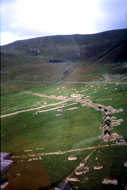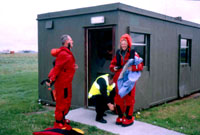|
Mission to the Back of Beyond: St. Kilda - November
2002
Experts from
the World Heritage Centre conduct frequent missions around the world
to carry out the Centre's multiple roles - managing international
assistance from the 4 million dollar World Heritage Fund, coordinating
reporting on the condition of World Heritage sites and mobilising
emergency action when a site is threatened and advising States Parties.
Dr Mechtild Rössler, chief of the World Heritage Centre's European
region, carried out a joint mission with the Scottish Executive in
August to one of Europe's most remote World Heritage site. The Vikings
first discovered St. Kilda, a volcanic archipelago lying beyond Scotland's
Outer Hebrides islands in a windswept outpost of the North Atlantic.
The archipelago, comprising the islands of Hirta, Dun, Soay and Boreray,
was inhabited for 4000 years.
The trip involved flying from Glasgow to Ben Becula in the Outer Hebrides,
then taking a military helicopter to the islands. Travel in the region
is often impossible because of high winds and notoriously bad weather.
"It's very difficult to get to because it can be dangerous,"
Rössler said. "That's why they put me in that funny survival
suit. I was in Gortex up to my ears." An archaeologist and the
warden, who lives on the island during the summer months, met the
mission.
St. Kilda's joined the World Heritage List in 1986 as a natural site
for its spectacular landscapes including some of the highest cliffs
in Europe, and for providing a refuge for impressive colonies of rare
and endangered bird species, especially puffins and gannets.
|
 |
 The Bay at Hirta - a difficult landing place
for boats and helicopters and the settlement of a vanished island
community.
The Bay at Hirta - a difficult landing place
for boats and helicopters and the settlement of a vanished island
community. |
 "I was in Gortex up to my ears. These
survival suits don't make the Paris fashion shows. " (Military
base, Benbecula, Outer Hebrides)
"I was in Gortex up to my ears. These
survival suits don't make the Paris fashion shows. " (Military
base, Benbecula, Outer Hebrides) |
 |
But
the site also has a unique cultural heritage, having been home for
centuries to a community that lived by catching and eating the birds,
making featherbeds for export, and raising sheep for wool and tweed
production. St. Kilda is "one of the most fascinating [World
Heritage] sites in terms of the history of human occupation of the
islands," Rössler said. "It was my dream for years
to go there."
The inhabitants of the islands, who spoke a form of Gaelic, lived
in the same way for centuries, even evolving longer and more muscular
toes in order to climb the rocks barefooted to hunt the birds, which
they caught by hand. But by the early 20th century the community
began to fail with a drop in demand for featherbeds. Finally, 36
surviving members were evacuated together in 1930. The settlement
they left behind is thus "frozen in time," Rössler
says. "You can even see the field systems they used."
|
Rössler's
mission was to look into a twofold proposal to re-nominate the site
for its cultural values, specifically as a "fossil cultural landscape",
and to extend the limits of the site to include the surrounding marine
area and its spectacular underwater scenery of cliffs, caves and gullies.
The mission also discussed the new management plan for the site which
is being finalized.
St. Kilda's could thus become one of the few sites on the World Heritage
List to have both natural and cultural values. Currently only 23 of
the List's 730 properties are mixed.
|
|
  The domed structure in the background is
a cleit, used for drying and storing birds for food during the harsh
winter months (with Deputy Minister for the Environment and Rural
Development, Mr Allan Wilson)
The domed structure in the background is
a cleit, used for drying and storing birds for food during the harsh
winter months (with Deputy Minister for the Environment and Rural
Development, Mr Allan Wilson) |
Back
|
 |





